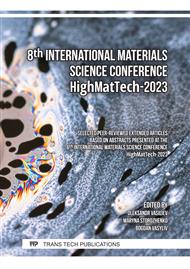[1]
M.C. Gao, J.-W. Yeh, P.K. Liaw, Y. Zhang, High Entropy Alloys. Fundamentals and Applications, Springer International Publishing, Switzerland, 2016.
Google Scholar
[2]
Y. Liu, L. Pu, Y. Yang, Q. He, Z. Zhou, C. Tan, X. Zhao, Q. Zhang, K. N. Tu, A high-entropy alloy as very low melting point solder for advanced electronic packaging, Materials Today Advances 7 (2020) 100101.
DOI: 10.1016/j.mtadv.2020.100101
Google Scholar
[3]
D. Luo, Y. Xiao, L. Hardwick, R. Snell, M. Way, X. S. Morell, F. Livera, N. Ludford, C. Panwisawas, H. Dong, R. Goodall, High Entropy Alloys as Filler Metals for Joining, Entropy 23 (2021) 78.
DOI: 10.3390/e23010078
Google Scholar
[4]
Yu. Plevachuk, V. Sklyarchuk, Electrophysical measurements for strongly aggressive liquid semiconductors, Meas. Sci. Technol. 12(1) (2001) 23-26.
DOI: 10.1088/0957-0233/12/1/303
Google Scholar
[5]
F-Q. Zu, R-R. Shen, Y. Xi, X-F. Li, G-H. Ding, H-M. Liu, Electrical resistivity of liquid Sn–Sb alloy, J. Phys.: Condens. Matter 18 (2006) 2817-2823.
DOI: 10.1088/0953-8984/18/10/007
Google Scholar
[6]
C. Li, S. Du, D. Zhao, G. Zhou, H. Geng, Electrical resistivity feature of Cu–Sn–(Bi) alloy melts, Phys. Chem. Liq., 52 (2014) 122-129.
DOI: 10.1080/00319104.2013.806214
Google Scholar
[7]
Yu. Plevachuk, V. Sklyarchuk, A. Yakymovych, P. Svec, D. Janickovic, E. Illekova, Electrical conductivity and viscosity of liquid Sn–Sb–Cu alloys, J Mater Sci: Mater Electron. 22 (2011) 631-638.
DOI: 10.1007/s10854-010-0188-6
Google Scholar
[8]
A. Roll, H. Motz, Der elektrische Widerstand von metallischen Schmelzen. II II. Der elektrische Widerstand geschmolzener Kupfer-Zinn-, Silber-Zinn- und Magnesium-Blei-Legierungen, Z. Metallkde. 48 (1957) 435-444.
DOI: 10.1515/ijmr-1957-480803
Google Scholar
[9]
D.M. North, C.N.J. Wagner, Atomic distributions in liquid copper-tin alloys, Phys. Chem. Liq., 2 (1970) 87-113.
Google Scholar
[10]
Yu. Plevachuk, V. Sklyarchuk, N. Shevchenko, S. Eckert. Electrophysical and structure-sensitive properties of liquid Ga–In alloys. Int. J Mater. Research, 106 (2015) 66-71
DOI: 10.3139/146.111151
Google Scholar
[11]
Ch. Holzhey, H. Coufal, G. Schubert, J. Brunnhuber, S. Sotier, The Electrical Resistivity of Liquid Cu1-xGax Alloys, Z. Physik B 33 (1979) 25-29.
DOI: 10.1007/bf01325810
Google Scholar
[12]
L.-S. Chang, B. Straumal, E. Rabkin, W. Gust, F. Sommer, The solidus line of the Cu–Bi phase diagram, J. Phase Equil. 18(2) (1997) 128-135.
DOI: 10.1007/bf02665694
Google Scholar
[13]
S. M. Clarke, M. Amsler, J.P.S. Walsh, T. Yu, Y. Wang, Y. Meng, S. D. Jacobsen, C. Wolverton, D. E. Freedman, Creating Binary Cu–Bi Compounds via High-Pressure Synthesis: A Combined Experimental and Theoretical Study, Chem. Mater. 29 (2017) 5276-5285.
DOI: 10.1021/acs.chemmater.7b01418
Google Scholar
[14]
K. Khalouk, C. Chaïb, J.-G. Gasser, Electrical and thermal conductivities and Seebeck coefficient of liquid copper-bismuth alloys, Philosophical Magazine, 89 (2009) 249-262.
DOI: 10.1080/14786430802607085
Google Scholar
[15]
Yu. Plevachuk, V. Sklyarchuk, G. Gerbeth, S. Eckert. Thermophysical properties of liquid tin-bismuth alloys. Int. J Mater. Research, 101 (2010) 839-844.
DOI: 10.3139/146.110357
Google Scholar
[16]
O. Teppo, J. Niemelä, P. Taskinen, An assessment of the thermodynamic properties and phase diagram of the system Bi-Cu. Thermochim. Acta, 173 (1990) 137-150.
DOI: 10.1016/0040-6031(90)80598-s
Google Scholar
[17]
D. Li, P. Franke, S. Fürtauer, D. Cupid, H. Flandorfer, The Cu-Sn phase diagram part II: New thermodynamic assessment. Intermetallics, 34 (2013) 148-158.
DOI: 10.1016/j.intermet.2012.10.010
Google Scholar
[18]
J.-B. Li, L.N. Ji, J.K. Liang, Y. Zhang, J. Luo, C.R. Li, G.H. Rao, A thermodynamic assessment of the copper-gallium system. Calphad, 32(2) (2008) 447-453.
DOI: 10.1016/j.calphad.2008.03.006
Google Scholar
[19]
I. Egry, E. Ricci, R. Novakovic, S. Ozawa, Surface tension of liquid metals and alloys-recent developments. Adv. Colloid. Interface Sci. 159, (2010) 198-212.
DOI: 10.1016/j.cis.2010.06.009
Google Scholar
[20]
J.-H. Shim, Ch.-S. Oh, B.-J Lee, D. N. Lee, Thermodynamic Assessment of the Cu-Sn System. Int. J. Mater. Res., 87(3) (1996) 205-212.
Google Scholar
[21]
D. Giuranno, F. Gnecco, E. Ricci, R. Novakovic, Surface tension and wetting behaviour of molten Bi-Pb alloys. Intermetallics, 11(11-12) (2003) 1313-1317.
DOI: 10.1016/s0966-9795(03)00173-0
Google Scholar
[22]
R. Novakovic, E. Ricci, D. Giuranno, A. Passerone, Surface and transport properties of Ag-Cu liquid alloys. Surf. Sci. 576(1-3) (2005) 175-187.
DOI: 10.1016/j.susc.2004.12.009
Google Scholar
[23]
T. Iida, R.I.L. Guthrie, The Physical Properties of Liquid Metals. Clarendon Press, Oxford (1993)
Google Scholar
[24]
B. Oleksiak, J. Łabaj, J. Wieczorek, A. Blacha-Grzechnik, R. Burdzik, Surface Tension of Cu–Bi Alloys and Wettability in a Liquid Alloy – Refractory Material – Gaseous Phase System. Arch. Metall. Mater. 59(1) (2014) 281-285.
DOI: 10.2478/amm-2014-0046
Google Scholar
[25]
R. Novakovic, D. Giuranno, E. Ricci, S. Delsante, D. Li, G. Borzone, Bulk and surface properties of liquid Sb-Sn alloys, Surf. Sci. 605 (2011) 248-255.
DOI: 10.1016/j.susc.2010.10.026
Google Scholar
[26]
G. Drath, F. Sauerwald, Die Oberflächenspannung geschmolzener Metalle und Legierungen. II. Die Oberflächenspannung von Zinn, Blei, Antimon, Kupfer, Zinn‐Wismut, Blei‐Wismut, Kupfer‐Antimon, Kupfer‐Zinnlegierungen und Gußeisen. Z. Anorg. Chem. 162(1) (1927) 301-320.
DOI: 10.1002/zaac.19271620128
Google Scholar
[27]
J. Lee, W. Shimoda, T. Tanaka, Surface tension and its temperature coefficient of liquid Sn-X (X=Ag, Cu) alloys. Mater. Trans. 45(9) (2004) 2864-2870.
DOI: 10.2320/matertrans.45.2864
Google Scholar
[28]
Y. Kawai, M. Kishimoto, H. Tsuru, Nippon Kinz. Gakk. 37 (6) (1973) 668.
Google Scholar
[29]
S. Amore, E. Ricci, T. Lanata, R. Novakovic, Surface tension and wetting behaviour of molten Cu-Sn alloys. J. Alloys Compd. 452(1) (2008) 161-166.
DOI: 10.1016/j.jallcom.2007.01.178
Google Scholar
[30]
Yu. Plevachuk, V. Sklyarchuk, S. Eckert, G. Gerbeth, R. Novakovic, Thermophysical Properties of the Liquid Ga-In-Sn Eutectic Alloy. J. Chem. Eng. Data, (2014) 59(3) 757-763.
DOI: 10.1021/je400882q
Google Scholar
[31]
F. Silze, G. Wiehl, I. Kaban, H. Wendrock, T. Gemming, U. Kühn, J. Eckert, S. Pauly, Wetting behaviour of Cu-Ga alloys on 304L steel. Materials & Design, 91 (2016) 11-18.
DOI: 10.1016/j.matdes.2015.11.034
Google Scholar



